INTRODUCTION
This report presents data that describe the 2011-12 pharmacy application pool, degrees conferred in 2011-12, and fall 2012 pharmacy program enrollments. Data for this report were requested from the 129 U.S. colleges and schools of pharmacy recognized by the Accreditation Council for Pharmacy Education (ACPE) using five separate survey instruments.
There were previously two professional education programs at U.S. colleges and schools of pharmacy: one leading to a baccalaureate in pharmacy, and the other leading to the doctor of pharmacy (Pharm.D.) degree. However, June 30, 2005 marked the official expiration of the ACPE standards to the baccalaureate in pharmacy (B.S. Pharmacy) degree programs in accordance with the transition to the doctor of pharmacy (Pharm.D.) degree as the sole professional degree program in the U.S. Some colleges and schools of pharmacy conferred degrees in the B.S. Pharmacy program until 2004-05.
For the purpose of this report, students in doctor of pharmacy programs are categorized under Pharm.D.1 when the program leads to a doctor of pharmacy degree conferred as the first professional degree. Students who have already received a baccalaureate in pharmacy and are enrolled in a doctor of pharmacy degree program are categorized under Pharm.D.2.
The following definitions refer to the race/ethnicity groups as used in this report. White refers to U.S. citizens or permanent residents having origins in any of the original peoples of Europe, the Middle East, or North Africa. Black or African American refers to U.S. citizens or permanent residents having origins in any of the black racial groups of Africa. Hispanic or Latino refers to U.S. citizens or permanent residents of Cuban, Mexican, Puerto Rican, South or Central American, or other Spanish culture or origin, regardless of race. Asian refers to U.S. citizens or permanent residents having origins in any of the original peoples of the Far East, Southeast Asia, or the Indian Subcontinent, including, for example, Cambodia, China, India, Japan, Korea, Malaysia, Pakistan, the Philippine Islands, Thailand, and Vietnam. Native Hawaiian or Other Pacific Islander refers to U.S. citizens or permanent residents having origins in any of the original peoples of Hawaii, Guam, Samoa, or other Pacific Islands. Prior to 2011, these students were included in the Asian category. American Indian or Alaska Native refers to U.S. citizens or permanent residents having origins in any of the original peoples of North and South America (including Central America) who maintains cultural identification through tribal affiliation or community attachment. Two or More Races refers to U.S. citizens or permanent residents who are not Hispanic/Latino and identify themselves by more than one race. Unknown refers to U.S. citizens or permanent residents whose race and ethnicity are not known. Prior to 2011, this category was labeled Other/Unknown and students that were of two or more races were included in this category. Finally, International/Foreign refers to citizens of a foreign country/permanent residents of a country other than the U.S.
2011-12 APPLICATION POOL
The 2011-12 Application Pool Survey was conducted online in November 2012, with an announcement and request for participation sent to the survey coordinator at each of the 129 colleges and schools of pharmacy in the U.S. recognized by ACPE. After follow-up correspondence and telephone calls, 127 colleges and schools (98.4 percent) submitted the requested information. Included in the application pool are students who applied for admission and submitted all required application materials between September 2011 and August 2012 for the entering class of fall 2012. Numbers reported represent the number of applications, not applicants, and may represent multiple applications submitted by individual applicants.
During the period September 2011 through August 2012, the reporting institutions received 99,821 applications for admission. When compared with entering class enrollment data for fall 2012 at these institutions, the resultant ratio was 6.4 applications received for every one entering student enrolled. The corresponding data for the 123 colleges and schools reporting for the same period in 2010-11 were 106,815 applications received; 7.0 applications for every one entering student enrolled in fall 2011. For the 123 colleges and schools reporting application data for both 2010-11 and 2011-12, there was an 8.1 percent decrease in the number of applications received.
In 2011-12, females submitted 59.9 percent of the applications to pharmacy colleges and schools; males submitted 39.0 percent; gender unknown/not reported submitted 1.0 percent. White Americans submitted 36.3 percent of the applications, Asian Americans submitted 34.2 percent of the applications, and underrepresented minorities submitted 16.0 percent of the applications (black, 10.2 percent; Hispanic, 5.3 percent; Native Hawaiian/Other Pacific Islander, 0.2 percent; American Indian/Alaska Native, 0.2 percent). 2.1 percent of the applications to the Pharm.D. as the first professional degree programs were from applicants of two or more races and 4.4 percent of the applications were submitted by foreign, nonpermanent residents [Table 1]. For the eighth consecutive year, colleges and schools of pharmacy received more applications from out-of-state residents (58.6 percent) compared to 41.4 percent from in-state residents. This increase in out-of-state applicants can be attributed to the ease of applying to colleges and schools of pharmacy in different states through PharmCAS.
Table 1.
Distribution of 2011-2012 Applications by Gender and Race/Ethnicity of Applicanta
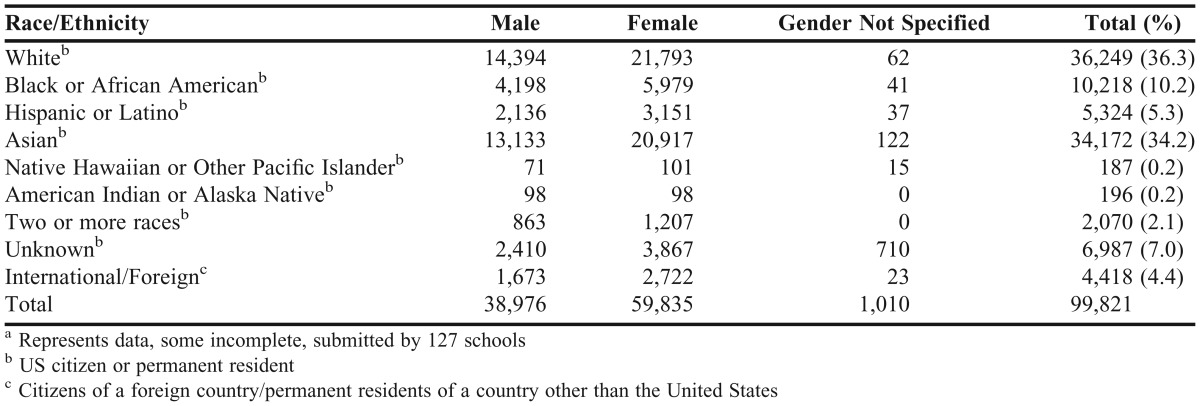
Over 44 percent (44.4 percent) of the applications to the Pharm.D. as the first professional degree programs were submitted by individuals who had previously obtained a baccalaureate degree or higher (baccalaureate, 41.4 percent; master's, 2.7 percent; doctorate, 0.3 percent), down from 45.4 percent the previous year [Table 2]. Over 75 percent (75.2 percent) of the applications to colleges and schools of pharmacy were submitted by individuals who had 3 or more years of postsecondary experience.
Table 2.
Distribution of 2011-2012 Applications to First Professional Degree Programs by Gender and Previous Postsecondary Experience of Applicanta

2011-12 DEGREES CONFERRED
The 2011-12 Professional Degrees Conferred and Graduate Degrees Conferred surveys were conducted online in November 2012, with an announcement and request for participation sent to the survey coordinator at each of the 129 colleges and schools of pharmacy in the U.S. recognized by ACPE. Submission of the data was requested by December 2012. After follow-up correspondence and telephone calls, 127 colleges and schools (98.4 percent) submitted the requested information.
Professional Degrees Conferred
Numbers of degrees conferred by U.S. colleges and schools of pharmacy from 1965 to 2012 are presented in Table 3.
Table 3.
Number of Pharmacy Degrees Conferred 1965-2012 by Degree and Gender
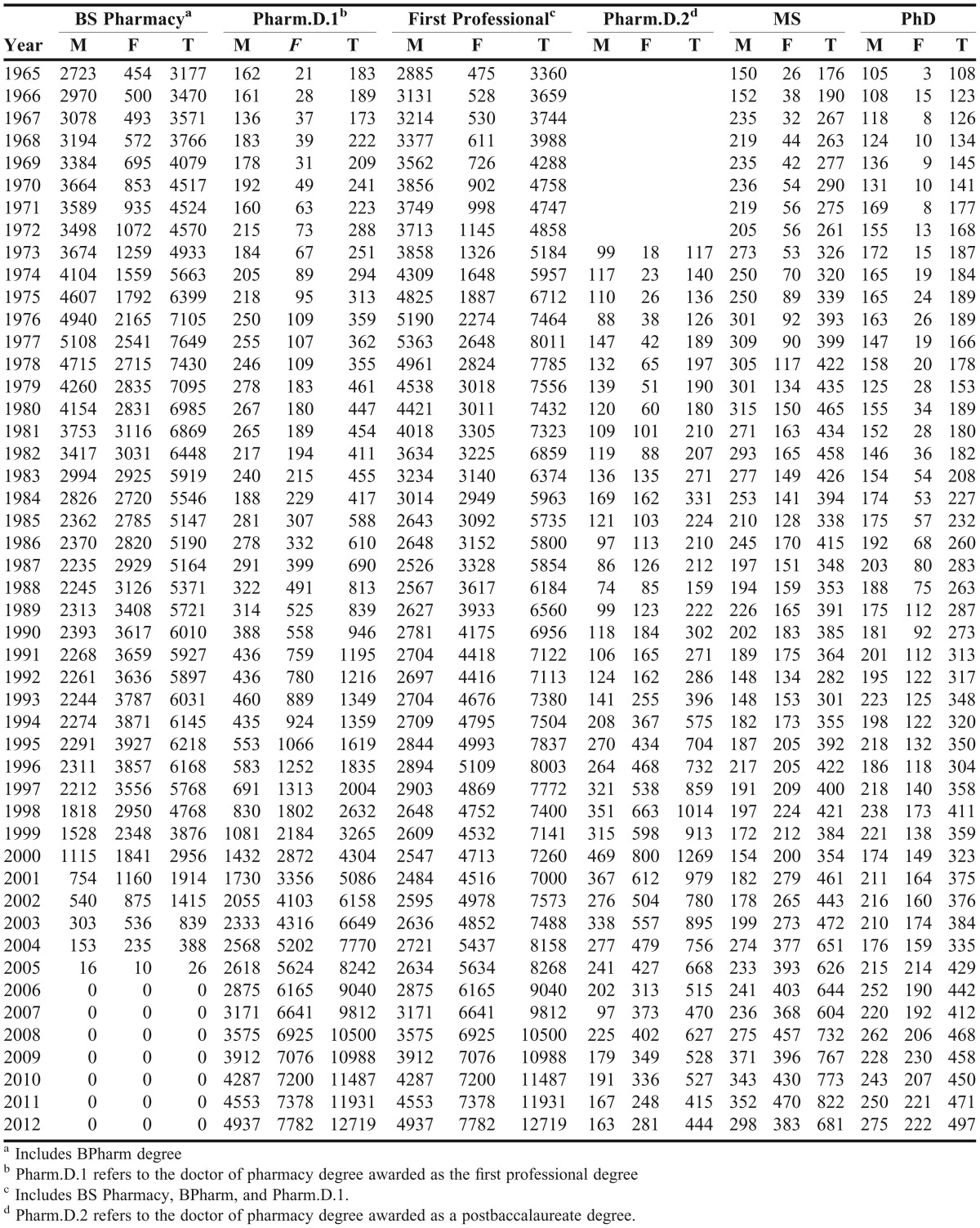
First Professional Degrees Conferred.
In 2011-12, 110 colleges and schools conferred the doctor of pharmacy as a first professional degree (Pharm.D.1). Graduating Pharm.D.1 class sizes ranged from 27 students to 307 students (median, 103 students). Seventeen of the 127 colleges and schools of pharmacy did not confer degrees in 2011-12. These schools were new programs whose students had not yet progressed through the entire curriculum (Regis, Saint Joseph, South Florida, PCOM-Georgia, Roosevelt, Rosalind Franklin, Manchester, Husson, New England, Notre Dame, Maryland Eastern Shore, Western New England, Fairleigh Dickinson, D’Youville, Cedarville, Presbyterian, and Concordia).
In 2011-12 there were 12,719 first professional degrees conferred by colleges and schools of pharmacy compared to 11,931 in 2010-11. [Table 4]. The total number of first professional degrees conferred in 2011-12 represented a 6.6 percent increase from the total number of first professional degrees conferred in 2010-11 [Table 5].
Table 4.
Baccalaureate and Doctor of Pharmacy (Pharm.D.1) Degrees as Percentages of Total First Professional Degrees Conferred 1981-2012
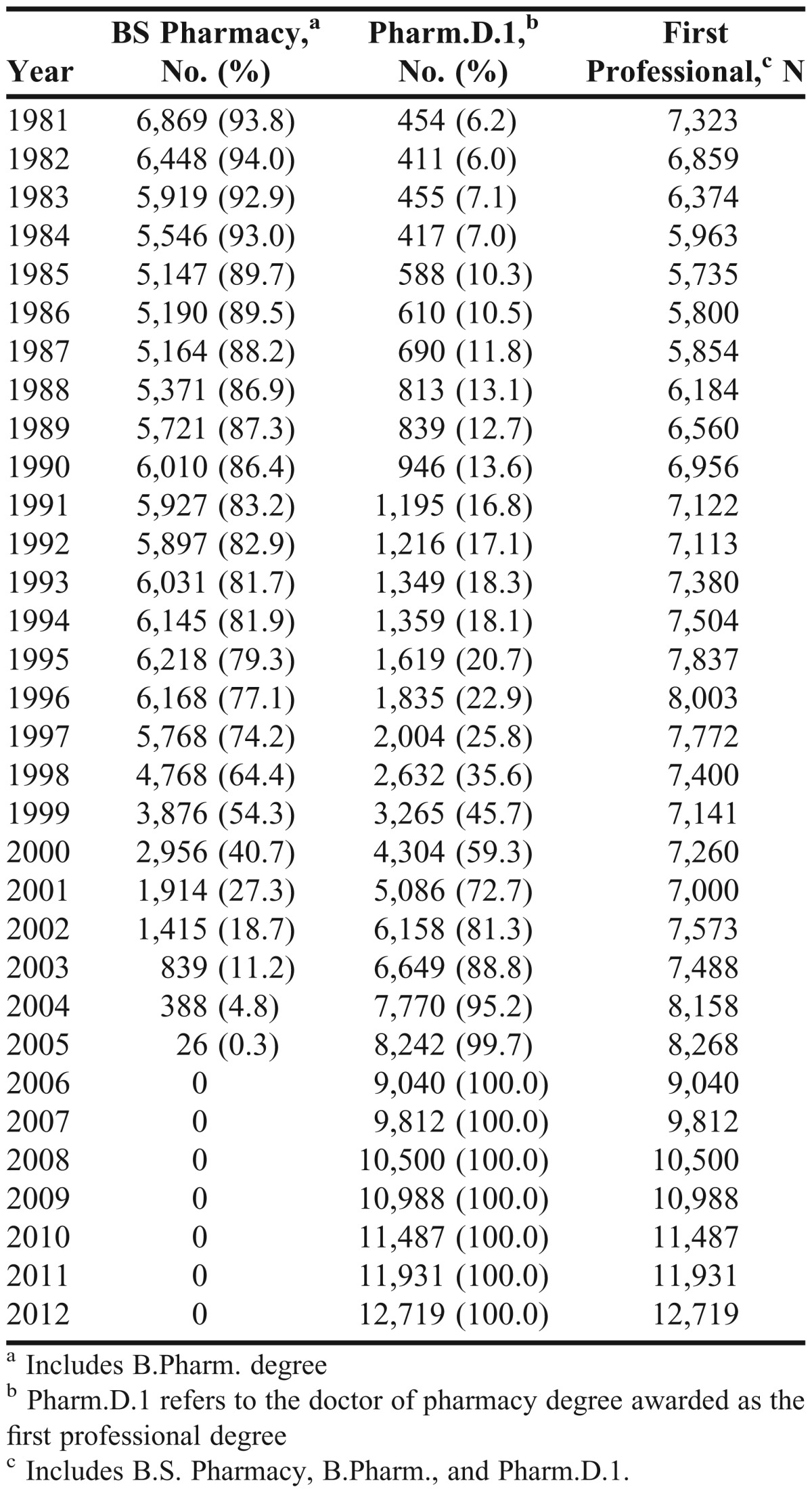
Table 5.
Annual Percentage Change in Number of Pharmacy Degrees Conferred 1981-2012 Over Previous Year
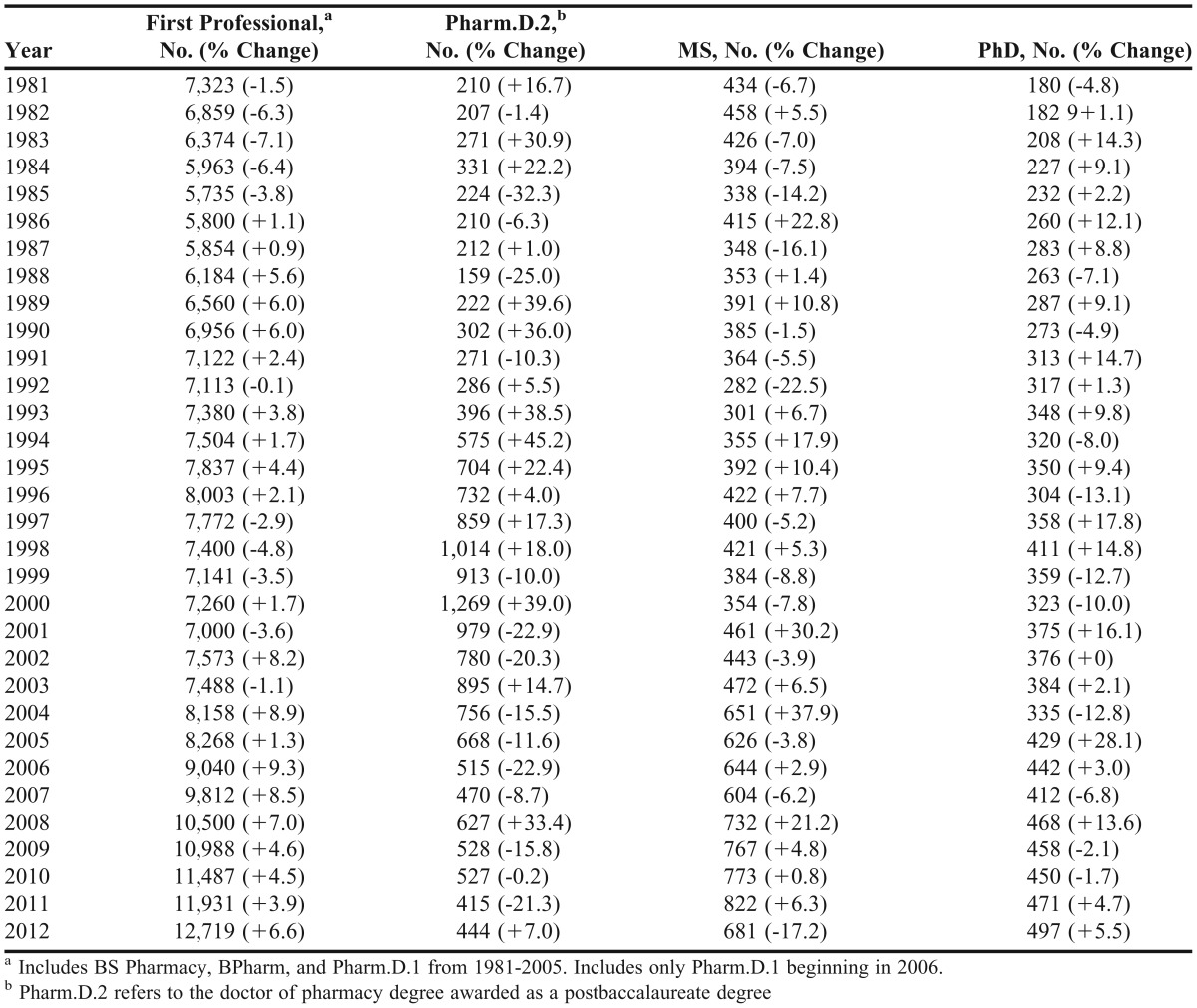
In 1979-80, men received 59.5 percent of the first professional degrees conferred by colleges and schools of pharmacy and women received 40.5 percent. Over the past 30 years, these percentages have shifted dramatically and, in 2011-12, men received 38.8 percent of the first professional degrees conferred, and 61.2 percent of these degrees were received by women. Women received their highest percentage of degrees conferred (68.2 percent) in 2004-05 and 2005-06. [Table 6].
Table 6.
Percentage of Pharmacy Degrees Conferred 1980-2012 by Gender

White Americans received 58.1 percent of first professional degrees conferred in 2011-12. Underrepresented minorities received 12.8 percent of the first professional degrees conferred in 2011-12 (black, 6.5 percent; Hispanic, 4.2 percent; Native Hawaiian/Other Pacific Islander, 1.6 percent; American Indian/Alaska Native, 0.5 percent). Asian Americans received 21.9 percent of the first professional degrees. The percentage of first professional degree recipients who were of two or more races was 0.8 percent and the percentage of recipients who were foreign, nonpermanent residents of the U.S. was 2.2 percent. [Table 7].
Table 7.
Percentage of First Professional Degree (BS Pharmacy, BPharm, and Pharm.D.1) Recipients 1980-2012 by Race/Ethnicity

Doctor of Pharmacy Degrees Conferred to Postbaccalaureate Students.
Seventeen colleges and schools conferred the Pharm.D. degree to postbaccalaureate students in 2011-12. The number of graduates per institution ranged from 1 to 179 students (median, 12 students). The number of doctor of pharmacy degrees conferred as postbaccalaureate degrees (Pharm.D.2) increased by 7.0 percent to 444 in 2011-12 from 415 in 2010-11 [Table 5]. More women than men received Pharm.D.2 degrees in 2011-12 (women, 63.3 percent; men, 36.7 percent) [Table 6].
White Americans received 41.0 percent of Pharm.D.2 degrees conferred in 2011-12. Underrepresented minorities received 16.2 percent of the Pharm.D.2 degrees conferred (black, 10.4 percent; Hispanic, 5.9 percent; Native Hawaiian/Other Pacific Islander, 0.0 percent; American Indian/Alaska Native, 0.0 percent). Asian Americans received 21.6 percent of the Pharm.D.2 degrees conferred in 2011-12. Students of two or more races did not receive any Pharm.D.2 degrees in 2011-12. The percentage of Pharm.D.2 degree recipients who were foreign, nonpermanent residents of the U.S. was 11.7 percent, down from 15.9 percent in 2010-11 [Table 8].
Table 8.
Percentage of Postbaccalaureate Doctor of Pharmacy Degree (Pharm.D.2) Recipients 1980-2012 by Race/Ethnicity
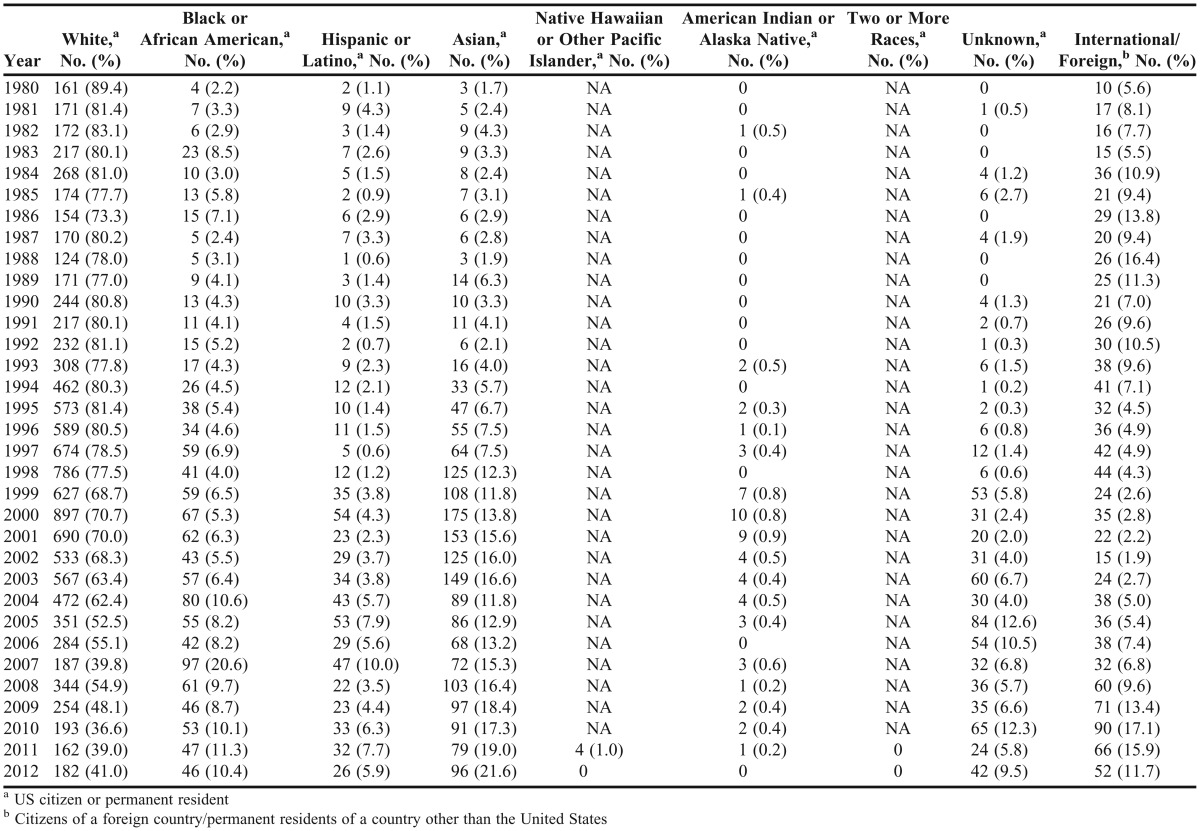
Graduate Degrees Conferred
The number of master of science (M.S.) degrees conferred has shown annual fluctuations over the 47 years data have been consistently gathered and reported [Table 3]. The number of M.S. degrees conferred decreased from 822 in 2010-11 to 681 in 2011-12, a 17.2 percent decrease. The number of Ph.D. degrees conferred increased in 2011-12 to 497 from 471 in 2010-11 (5.5 percent increase) [Table 5].
The highest percentage of M.S. degrees awarded in 2011-12 (25.1 percent) was in pharmaceutics. The second highest percentage of M.S. degrees was in other discipline (21.4 percent); followed by social and administrative sciences (21.1 percent); pharmacy practice (15.3 percent); medicinal chemistry (9.0 percent); and pharmacology (8.1 percent). The highest number of Ph.D. degrees awarded in 2011-12 was in the discipline of pharmaceutics (38.2 percent). The second highest number was in medicinal chemistry (22.5 percent); followed by pharmacology (18.7 percent); social and administrative sciences (8.2 percent); other discipline (7.0 percent); and pharmacy practice (5.2 percent) [Table 9].
Table 9.
Summary of Master of Science and Doctor of Philosophy Degrees Conferred 2011-12 by Gender and Discipline
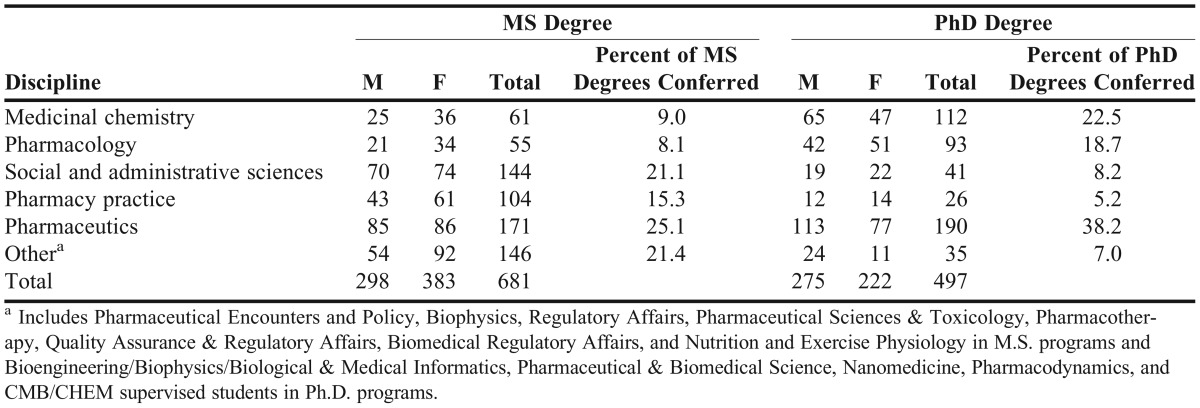
More women than men earned M.S. degrees (women, 56.2 percent; men, 43.8 percent) in 2011-12; however, more men than women earned Ph.D. degrees (women, 44.7 percent; men, 55.3 percent). 2008-09 was the only year that women received more Ph.D. degrees than men. The percentage of women receiving Ph.D. degrees in 2011-12 decreased from 46.9 percent in 2010-11. Despite the decrease from the 2008-09 high, the share of Ph.D. degrees received by women has grown substantially from 18.0 percent in 1979-80 [Table 6]. This increase can be attributed to an increase in the number of foreign females receiving Ph.D. degrees. Black, Hispanic, and American Indian/Alaska Native women have a propensity to be underrepresented as Ph.D. recipients. In 2011-12, 14 black women, 11 Hispanic women, and 1 American Indian woman received Ph.D.s. From 1979-80 to 2011-12, 185 Ph.D. degrees were conferred to black women, 73 to Hispanic women, and 6 to American Indian women. [Table 10].
Table 10.
Number of Doctor of Philosophy Degrees (PhD) Conferred 1980-2012 by Gender and Race/Ethnicity
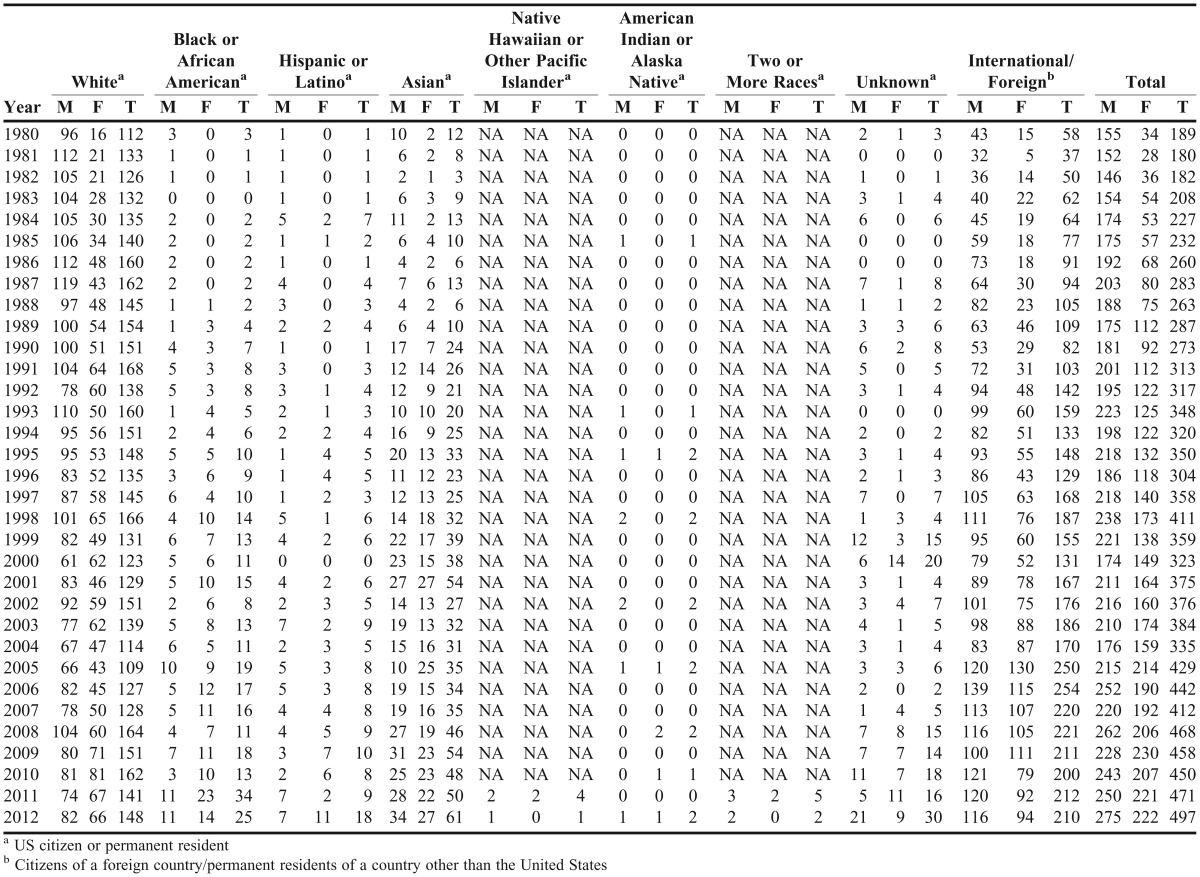
Underrepresented minorities received 6.5 percent of the M.S. degrees conferred in 2011-12 (black, 3.5 percent; Hispanic, 2.2 percent; Native Hawaiian/Other Pacific Islander, 0.1 percent; American Indian/Alaska Native, 0.6 percent), a decrease from 7.1 percent in 2010-11. Asian Americans received 11.9 percent of the M.S. degrees conferred, up from 9.5 percent in 2010-11. The percentage of M.S. degree recipients who were of two or more races was 0.4 percent and the percent of degree recipients who were foreign, nonpermanent residents of the U.S. was 45.4 percent, down from 46.7 percent in 2010-11 [Table 11].
Table 11.
Percentage of Master of Science (MS) Degree Recipients 1990-2012 by Race/Ethnicity
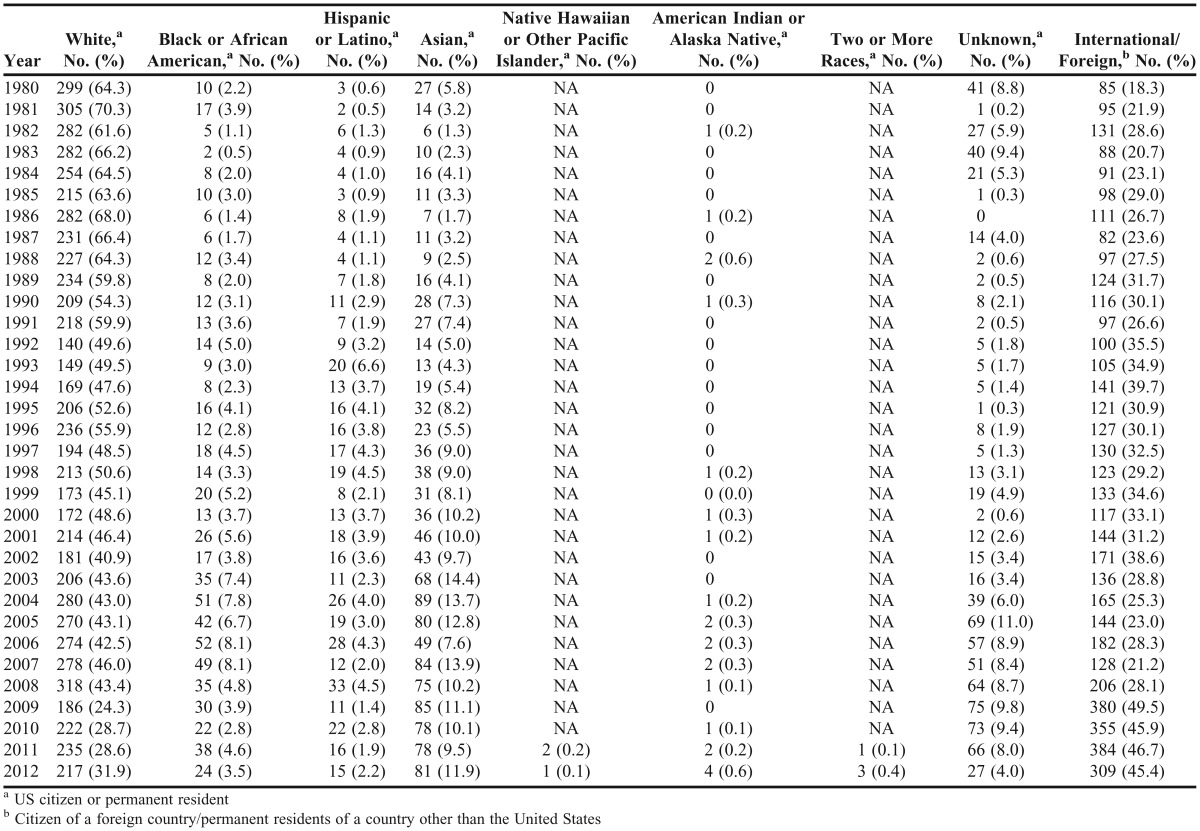
Underrepresented minorities earned 9.3 percent of the Ph.D. degrees awarded in 2011-12 (black, 5.0 percent; Hispanic, 3.6 percent; Native Hawaiian/Other Pacific Islander, 0.2 percent; American Indian/Alaska Native, 0.4 percent), a decrease from 9.9 percent in 2010-11. Asian Americans earned 12.3 percent of the Ph.D. degrees awarded. The percentage of Ph.D. degree recipients who were of two or more races was 0.4 percent and the percentage of degree recipients that were foreign, nonpermanent residents of the U.S. was 42.3 percent, down from 45.0 percent in 2010-11. [Table 12].
Table 12.
Percentage of Doctor of Philosophy Degree (PhD) Recipients 1980-2012 by Race/Ethnicity

FALL 2012 ENROLLMENTS
The 2012 Professional Degree Enrollment and Graduate Degree Enrollment Surveys were conducted online in November 2012, with an announcement and request for participation sent to the survey coordinator at each of the 129 colleges and schools of pharmacy in the U.S. recognized by ACPE. Submission of the data was requested by December 2012. Follow-up telephone calls were made to non-responding colleges and schools and to those submitting incomplete data. After follow-up correspondence and telephone calls, 127 colleges and schools (98.4 percent) submitted the requested information.
Professional Degree Programs
Fall 2012 enrollments in the Pharm.D. as the first professional degree programs (n=61,275) represented a 4.0 percent increase from enrollments in fall 2011 (n=58,915) [Table 13]. In fall 2012, 61.0 percent of the students enrolled in the Pharm.D. as the first professional degree programs were females and 39.0 percent were males [Table 14].
Table 13.
Summary of Enrollments in First Professional Degree Programs 1980-2012
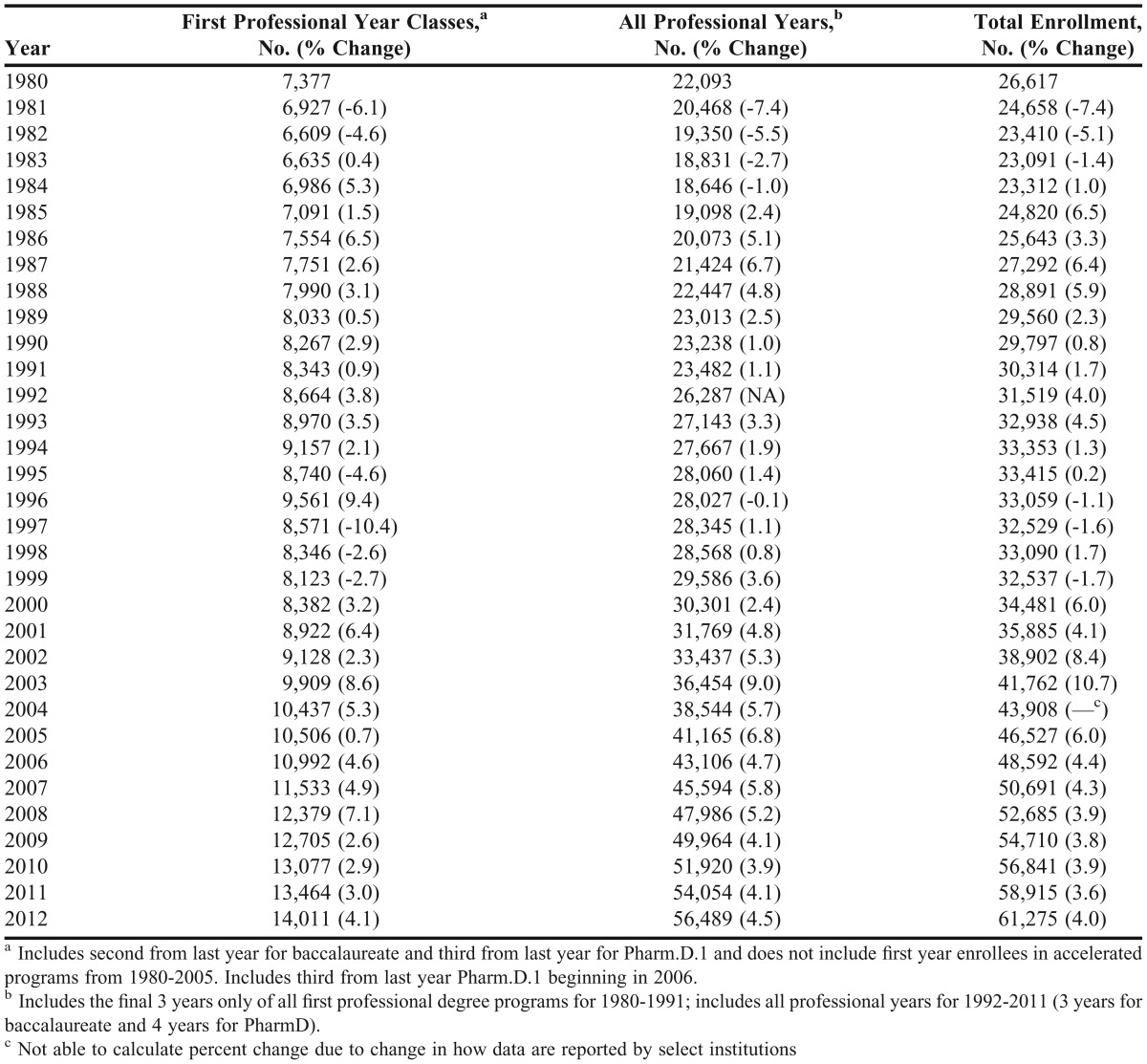
Table 14.
Summary of Enrollments in First Professional Degree Programs by Gender 1980-2012
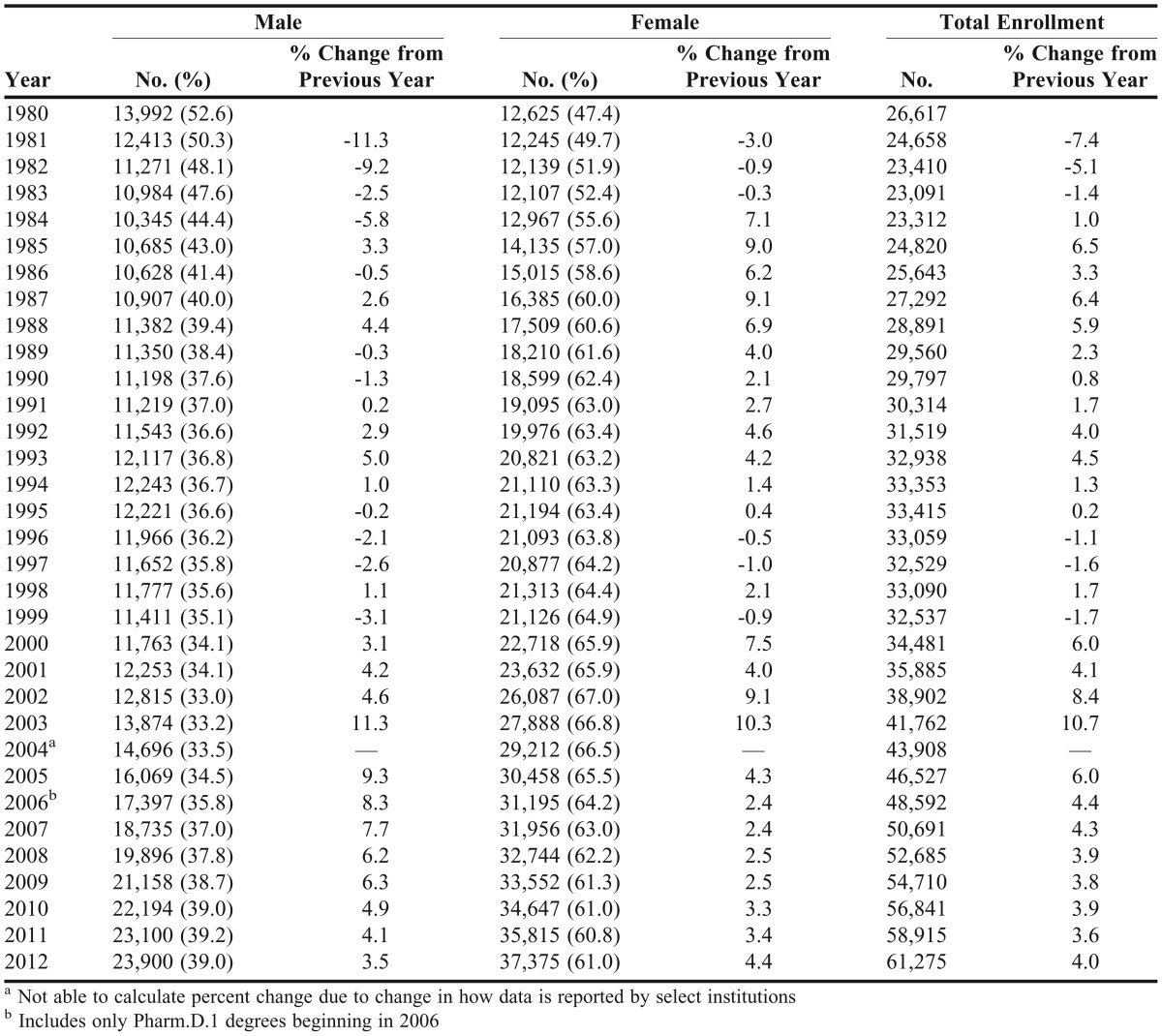
White Americans comprised the majority (53.2 percent) of students enrolled in the Pharm.D. as the first professional degree programs. Asian Americans accounted for 23.6 percent; black Americans, 6.9 percent; Hispanic Americans, 4.1 percent; Native Hawaiians/Other Pacific Islanders, 1.0 percent; American Indians/Alaska Natives, 0.4 percent; and foreign students, 2.8 percent. Students that identified as two or more races accounted for 1.6 percent of all first professional degree enrollments. Over 6 percent (6.4 percent) of enrollees were listed as unknown. Enrollments of underrepresented minorities (black, Hispanic, Native Hawaiian/Other Pacific Islander, American Indian/Alaska Native) as a percentage of total enrollments in the Pharm.D. as the first professional degree programs increased from fall 2011 to fall 2012 (11.5 percent in fall 2011 compared to 12.4 percent in fall 2012). The increase in the percentage of underrepresented minorities over the last 2 years can partially be attributed to the inclusion of Native Hawaiian/Other Pacific Islander as its own race/ethnicity category in 2011. Prior to 2011, Native Hawaiians/Other Pacific Islanders were included in the Asian category [Table 15].
Table 15.
Summary of Enrollments in First Professional Degree Programs by Race/Ethnicity 1980-2012
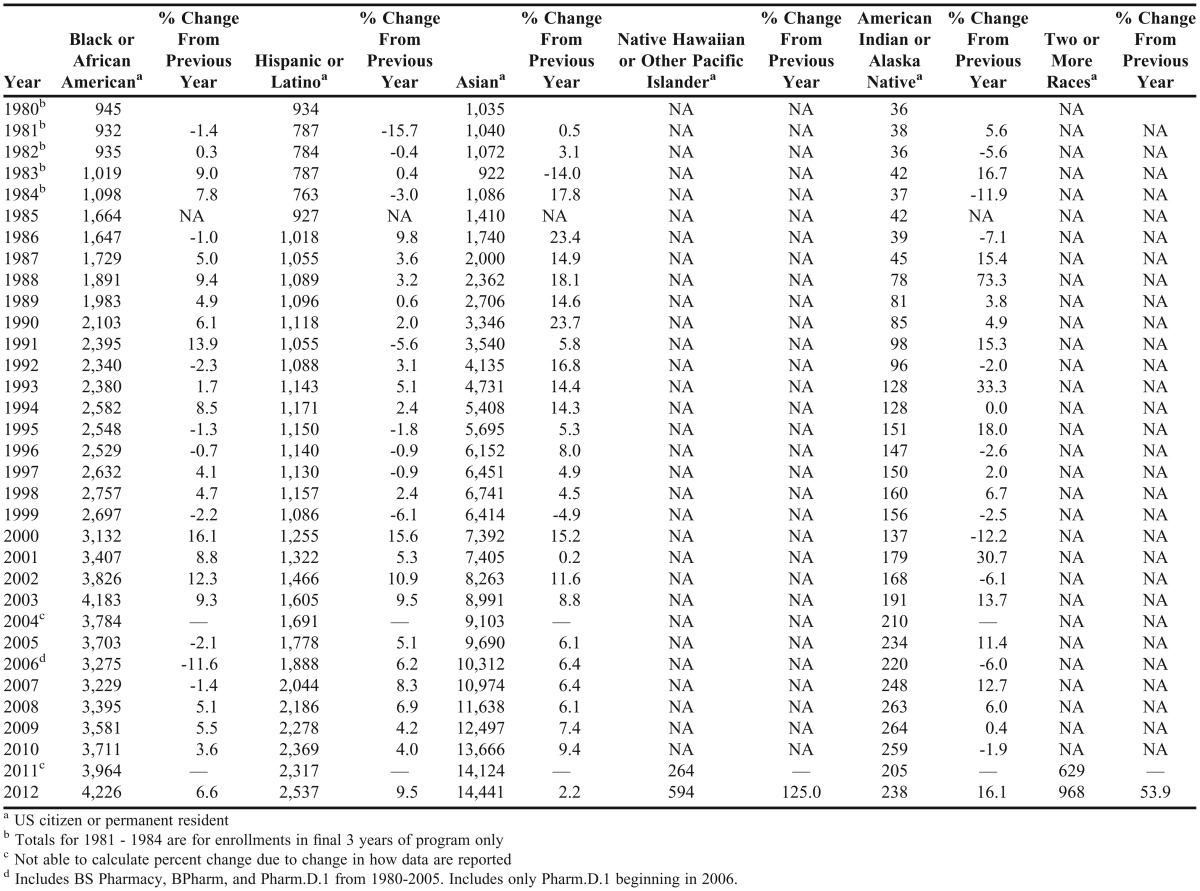
Seventeen colleges and schools reported 1,260 students who already held a baccalaureate in pharmacy enrolled in doctor of pharmacy degree programs (Pharm.D.2). This was a decrease of 6.0 percent from fall 2011. Underrepresented minorities accounted for 13.3 percent of these students (black, 9.7 percent; Hispanic, 3.1 percent; Native Hawaiians/Other Pacific Islander, 0.0 percent; American Indians/Alaska Native, 0.5 percent). White Americans comprised 34.3 percent; Asian Americans, 16.2 percent; students of two or more races, 0.4 percent; unknown, 17.8 percent; and foreign students, 18.1 percent.
Graduate Degree Programs
In fall 2012, the discipline of pharmaceutics had the highest percentage of full-time enrollees at both the M.S. and Ph.D. levels (28.8 percent and 32.3 percent, respectively). At the master's level, 20.1 percent of the students enrolled were in social and administrative sciences programs; 18.8 percent in pharmacology programs; 15.8 percent in pharmacy practice programs; 10.4 percent in medicinal chemistry programs; and 6.1 percent in other discipline. At the doctoral level, 24.4 percent of the students were enrolled in medicinal chemistry programs; 19.8 percent in pharmacology programs; 10.8 percent in social and administrative science programs; 9.0 percent in other discipline; and 3.6 percent in pharmacy practice [Table 16].
Table 16.
Summary of Master of Science (MS) and Doctor of Philosophy (PhD) Fall 2012 Full-Time Enrollments by Gender and Discipline
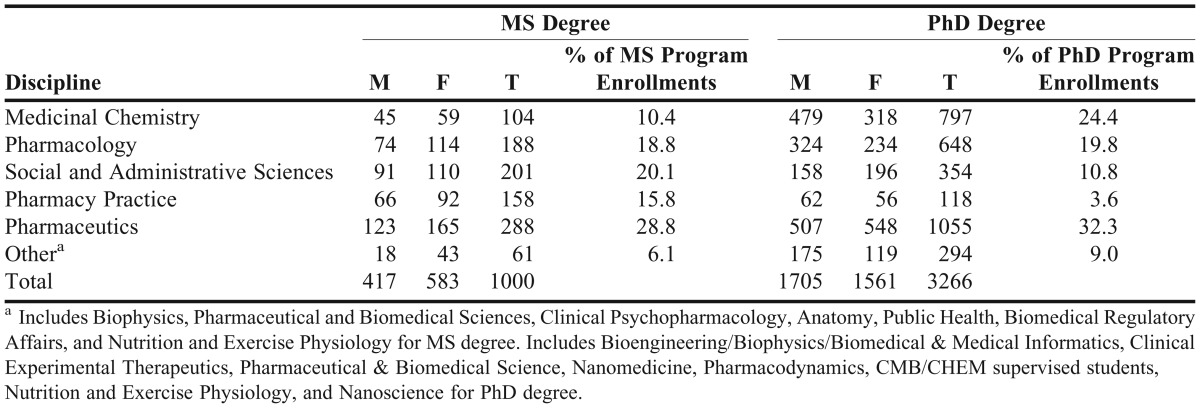
In fall 2012, more females than males were enrolled full-time in M.S. degree programs (females, 58.3 percent; males, 41.7 percent). Women accounted for 47.8 percent of the students enrolled full-time in Ph.D. programs in 2012, down slightly from 48.0 percent in 2011.
Of the 1,000 students enrolled full-time in M.S. degree programs in fall 2012, the majority (56.7 percent) were foreign students. White Americans comprised 23.4 percent of enrollees and Asian Americans accounted for 7.9 percent. Underrepresented minorities accounted for 8.5 percent of M.S.enrollees (black, 4.7 percent; Hispanic, 3.0 percent; American Indians/Alaska Native, 0.6 percent; Native Hawaiian/Other Pacific Islander, 0.2 percent). Americans of two or more races made up 0.2 percent of enrollees and 3.3 percent of all full-time M.S. degree enrollees were reported as unknown.
Of the 3,266 students enrolled full-time in Ph.D. degree programs in fall 2012, foreign students were also the largest group, accounting for 52.8 percent of the enrollees. Underrepresented minorities accounted for 7.4 percent of Ph.D. enrollees (black, 4.5 percent; Hispanic Americans, 2.4 percent; Native Hawaiian/Other Pacific Islander Americans, 0.3 percent; American Indians/Alaska Natives, 0.2 percent). Nearly 30 percent (29.8 percent) of Ph.D. enrollees were white Americans, Asian Americans accounted for 6.7 percent of the enrollees, and Americans of two or more races account for 0.5 percent. 2.8 percent of all full-time Ph.D. degree enrollees were reported as unknown. Over 40 percent (40.2 percent) of full-time and part-time students in Ph.D. programs held a professional pharmacy degree, 8.7 percent of Ph.D. students held a professional pharmacy degree from a U.S. college or school of pharmacy, and 31.5 percent held a pharmacy degree conferred by a non-U.S. institution [Table 17].
Table 17.
Fall 2012 Enrollments in PhD Programs by Type of Enrollment (Full-Time, Part-Time), Discipline, and Source of Previous Degree Earneda
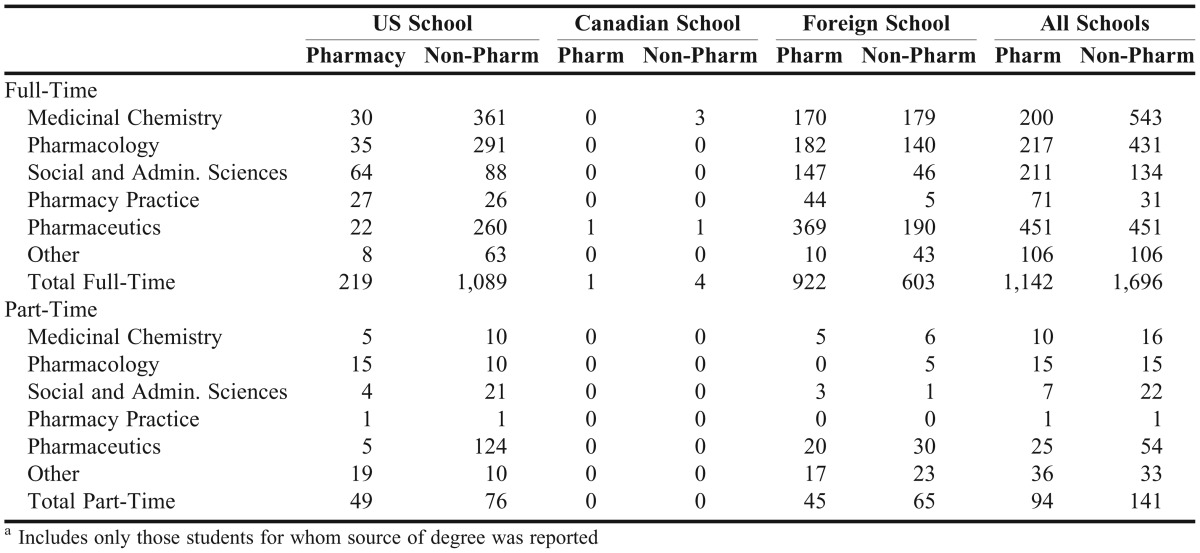
ACKNOWLEDGMENT
The American Association of Colleges of Pharmacy wishes to express its appreciation to the deans of its member institutions and members of their faculty and staff who devoted their valuable time to complete the surveys that led to this report.
This report is an excerpt from the Profile of Pharmacy Students—Fall 2012, published by the American Association of Colleges of Pharmacy (2013).


